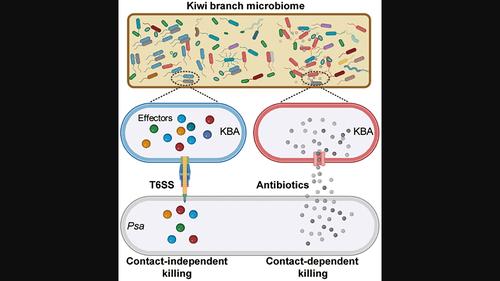当前位置:
X-MOL 学术
›
Mol. Plant Pathol.
›
论文详情
Our official English website, www.x-mol.net, welcomes your feedback! (Note: you will need to create a separate account there.)
Adapting the inoculation methods of kiwifruit canker disease to identify efficient biocontrol bacteria from branch microbiome
Molecular Plant Pathology ( IF 4.9 ) Pub Date : 2023-11-03 , DOI: 10.1111/mpp.13399 Xiaolong Shao 1 , Qianhua Wu 1 , Li Li 2 , Weimei He 1 , Xueting He 1 , Dongjin Cheng 1 , Aprodisia Murero 1 , Long Lin 1 , Limin Wang 1 , Caihong Zhong 2 , Lili Huang 3 , Guoliang Qian 1
Molecular Plant Pathology ( IF 4.9 ) Pub Date : 2023-11-03 , DOI: 10.1111/mpp.13399 Xiaolong Shao 1 , Qianhua Wu 1 , Li Li 2 , Weimei He 1 , Xueting He 1 , Dongjin Cheng 1 , Aprodisia Murero 1 , Long Lin 1 , Limin Wang 1 , Caihong Zhong 2 , Lili Huang 3 , Guoliang Qian 1
Affiliation

|
Pseudomonas syringae pv. actinidiae (Psa), the bacterium that causes kiwifruit bacterial canker, is a common field occurrence that is difficult to control globally. Currently, exploring the resources for efficient biocontrol bacteria is a hot spot in the field. The common strategy for isolating biocontrol bacteria is to directly isolate biocontrol bacteria that can secrete diffusible antibacterial substances, most of which are members of Bacillus, Pseudomonas and Streptomycetaceae, from disease samples or soil. Here, we report a new approach by adapting the typical isolation methods of kiwifruit canker disease to identify efficient biocontrol bacteria from the branch microbiome. Using this unique approach, we isolated a group of kiwifruit biocontrol agents (KBAs) from the branch microbiome of Psa-resistant varieties. Thirteen of these showed no antagonistic activity in vitro, which depends on the secretion of antibacterial compounds. However, they exhibited antibacterial activity via cell-to-cell contacts mimicked by co-culture on agar plates. Through biocontrol tests on plants, two isolates, KBA13 and KBA19, demonstrated their effectiveness by protecting kiwifruit branches from Psa infection. Using KBA19, identified as Pantoea endophytica, as a representative, we found that this bacterium uses the type VI secretion system (T6SS) as the main contact-dependent antibacterial weapon that acts via translocating toxic effector proteins into Psa cells to induce cell death, and that this capacity expressed by KBA19 is common to various Psa strains from different countries. Our findings highlight a new strategy to identify efficient biocontrol agents that use the T6SS to function in an antibacterial metabolite-independent manner to control wood diseases.
中文翻译:

采用猕猴桃溃疡病的接种方法从分支微生物组中鉴定有效的生防细菌
丁香假单胞菌pv. 猕猴桃细菌性溃疡病菌(Psa)是一种常见的田间现象,在全球范围内难以控制。目前,探索高效生防菌资源是该领域的热点。分离生防细菌的常用策略是直接从病害样品或土壤中分离出能够分泌扩散性抗菌物质的生防细菌,其中大多数是芽孢杆菌属、假单胞菌属和链霉菌科的成员 。在这里,我们报告了一种新方法,通过采用猕猴桃溃疡病的典型分离方法来从分支微生物组中识别有效的生物防治细菌。利用这种独特的方法,我们从 Psa 抗性品种的分支微生物组中分离出一组奇异果生物防治剂 (KBA)。其中 13 种在体外没有表现出拮抗活性,这取决于抗菌化合物的分泌。然而,它们通过琼脂平板上共培养模拟的细胞间接触表现出抗菌活性。通过对植物进行生物防治测试,两种分离株 KBA13 和 KBA19 证明了其能够保护猕猴桃枝条免受 Psa 感染的有效性。以内生泛菌KBA19为代表,我们发现该细菌使用VI型分泌系统(T6SS)作为主要的接触依赖性抗菌武器,通过将毒性效应蛋白转位到Psa细胞中来诱导细胞死亡,并KBA19 所表达的这种能力是来自不同国家的各种 Psa 菌株所共有的。我们的研究结果强调了一种新策略,用于识别有效的生物防治剂,该生物防治剂使用 T6SS 以不依赖抗菌代谢物的方式发挥作用,以控制木材病害。
更新日期:2023-11-03
中文翻译:

采用猕猴桃溃疡病的接种方法从分支微生物组中鉴定有效的生防细菌
丁香假单胞菌pv. 猕猴桃细菌性溃疡病菌(Psa)是一种常见的田间现象,在全球范围内难以控制。目前,探索高效生防菌资源是该领域的热点。分离生防细菌的常用策略是直接从病害样品或土壤中分离出能够分泌扩散性抗菌物质的生防细菌,其中大多数是芽孢杆菌属、假单胞菌属和链霉菌科的成员 。在这里,我们报告了一种新方法,通过采用猕猴桃溃疡病的典型分离方法来从分支微生物组中识别有效的生物防治细菌。利用这种独特的方法,我们从 Psa 抗性品种的分支微生物组中分离出一组奇异果生物防治剂 (KBA)。其中 13 种在体外没有表现出拮抗活性,这取决于抗菌化合物的分泌。然而,它们通过琼脂平板上共培养模拟的细胞间接触表现出抗菌活性。通过对植物进行生物防治测试,两种分离株 KBA13 和 KBA19 证明了其能够保护猕猴桃枝条免受 Psa 感染的有效性。以内生泛菌KBA19为代表,我们发现该细菌使用VI型分泌系统(T6SS)作为主要的接触依赖性抗菌武器,通过将毒性效应蛋白转位到Psa细胞中来诱导细胞死亡,并KBA19 所表达的这种能力是来自不同国家的各种 Psa 菌株所共有的。我们的研究结果强调了一种新策略,用于识别有效的生物防治剂,该生物防治剂使用 T6SS 以不依赖抗菌代谢物的方式发挥作用,以控制木材病害。



























 京公网安备 11010802027423号
京公网安备 11010802027423号